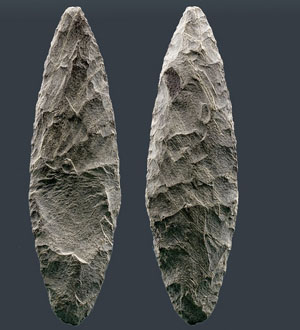Evidence for Pre-Clovis Inhabitants of Americas Emerges from Sea Floor
Source: ancient-origins.net
A fisherman inadvertently dragged up one of the most significant pieces of evidence for the existence of ancient inhabitants of North America prior to the Clovis people, who walked the land some 15,000 years ago. A small wooden scallop trawler was dredging the seafloor off the coastline of Chesapeake Bay, when he hit a snag. When he pulled up his net, he found a 22,000-year-old mastodon skull and a flaked blade made of a volcanic rock called rhyolite. A report in Live Science says that the combination of the finds may suggest that people lived in North America, and possibly butchered the mastodon, thousands of years before people from the Clovis culture, who are widely thought to be the first settlers of North America and the ancestors of all living Native Americans.
Most researchers believe the first Americans crossed the Bering Strait from Siberia about 15,000 years ago and quickly colonized North America. Artifacts from these ancient settlers, who have been named the Clovis culture after one of the archaeological sites in Clovis, New Mexico, have been found from Canada to the edges of North America. However, a number of discoveries in recent years have challenged the view that the Clovis were the first, and to date, no archaeological evidence of human settlements has ever been found in the Beringian land bridge.
The mastodon and stone tool finding further supports the perspective that there were other inhabitants of America that preceded the Clovis. The ancient fossil and tool were first hauled off the seafloor in 1974, and were donated to Gwynn’s Island Museum in Virginia, where they sat unnoticed for four decades. However, scientists have now realised the significance of the items after Dennis Stanford, an archaeologist with the Smithsonian Institution in Washington, D.C., carried out radiocarbon dating on the mastodon tusk and found it was more than 22,000 years old. While the stone tool cannot be dated, the characteristics of the artifact suggest it is also of the same age.
Both pieces show characteristic weathering that indicated they were exposed to the air for a while and then submerged in a saltwater marsh, before finally being buried in seawater, possible at the same time. Furthermore, the flint-knapping technique used to make it was similar to that found in Solutrean tools, which were made in Europe between 22,000 and 17,000 years ago. Taken together, the discovery gives credence to the Solutrean hypothesis, which proposes that the first inhabitants arrived by sea from southwest Europe millennia earlier than the Clovis.
[...]
Read the full article at: ancient-origins.net
Solutreans Are Indigenous Americans






















